PAINTING
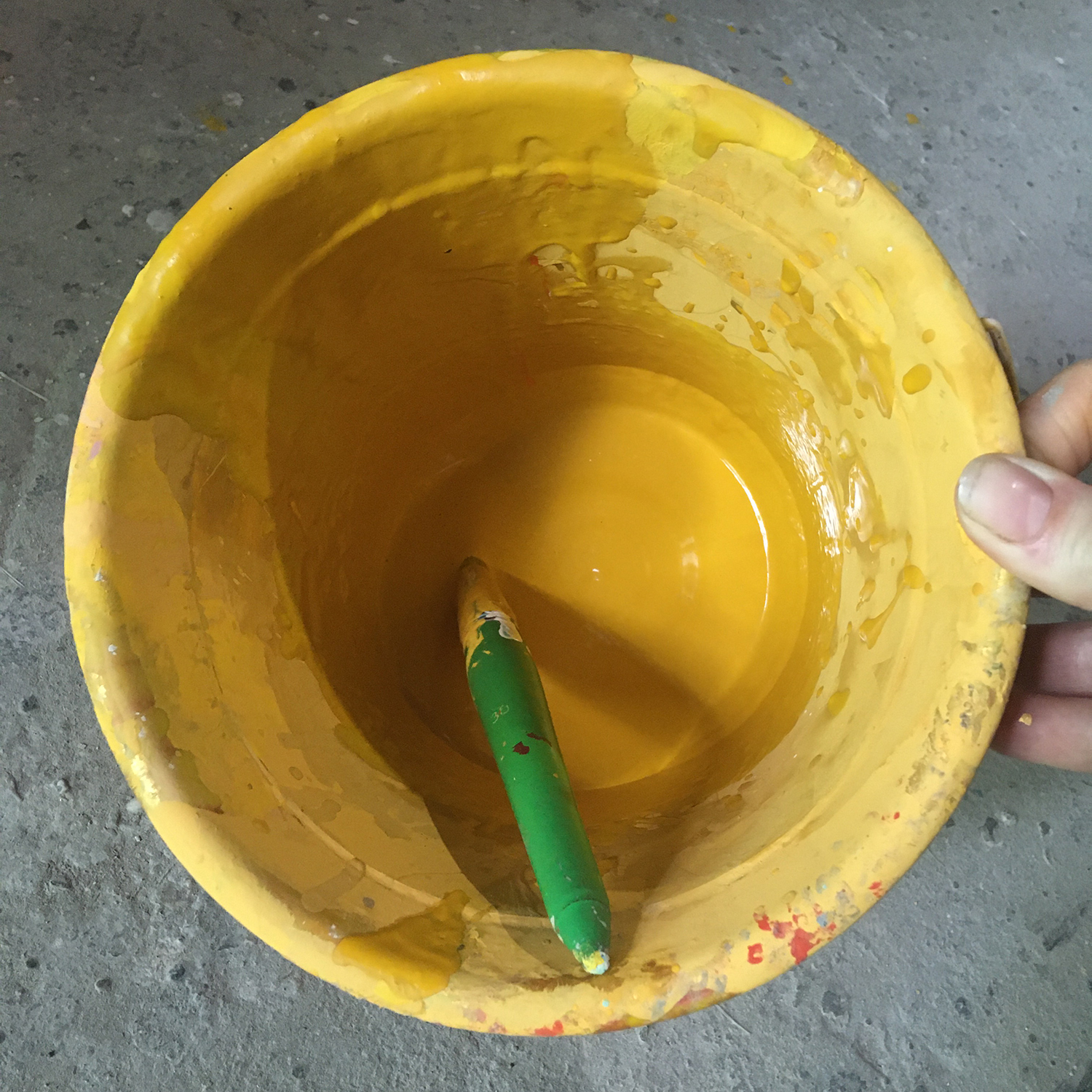

I’m tired today. The stress of the Coronavirus creep is starting to weigh more heavily on my shoulders. I’ve arranged to meet Nandita this afternoon, after my final session at Naba’s workshop, to discuss the evolving situation and the curtailment of my trip. We will meet at the Calcutta Club, a short walk from my guest house and where we had lunch on my first day. It’s a throwback from the time of British colonialism, now frequented, in the main, by older generations of the Indian aristocracy. It has a cool, nostalgic, colonial air with plenty of shade and ceiling fans, opening out to an inner veranda and sun-filled lawn. Nandita’s family are members but, she tells me, she’s not a regular visitor. Rather she’s chosen it for its proximity to my accommodation.
So, I’m distracted this morning, but working in the shade of the studio feels cathartic and I feel temporarily cocooned from what is going on outside. First, I apply a whitewash undercoat across the whole surface of the clay, a mix of fabric paint, water and PVA. Next a yellow ochre for the figure and a marine green for the base. The ochre initially dries to a mustard. Not knowing what the colour should be, I enjoy this mustard and it feels like a colour I would choose. There’s something modern and Germanic about it to my eye. ‘The yellow ochre needs to be brighter,’ says Naba in Bengali and it is duly remixed for me and I repaint. Annapurna is always the same yellow. Not mustard.
The painting of the face, hands and feet is intricate and particular and there is no room for error. ‘Are you sure you want to paint this yourself?’ I’m asked. ‘Perhaps you should take some spare heads to practice on at home and let us do this?’ Naba and Buddhadeb are polite and understanding now of my wish to try everything. Equally, by this stage, I realise the importance to them of the fact that this idol is coming from their workshop to England; that it will be a symbol of the quality of the workshop’s craftmanship. They want to feel pride in what they are sending me home with and they are nervous about what I can achieve with my first attempt. I realise it’s important I let them do the paint detailing.
The importance placed on the face painting goes further than I realise. It transpires that only Naba, as the owner of the workshop, is entrusted to paint the faces. This he does for every idol that leaves his workshop, even in the busy run up to Durga Puja. Not just anyone has the skill and talent to do this painting I’m told. It’s seen as the most challenging of all the processes, though I would argue there is the same, if not greater skill, in the production of the straw formwork and application of the clay.
The importance placed on the face painting goes further than I realise. It transpires that only Naba, as the owner of the workshop, is entrusted to paint the faces. This he does for every idol that leaves his workshop, even in the busy run up to Durga Puja. Not just anyone has the skill and talent to do this painting I’m told. It’s seen as the most challenging of all the processes, though I would argue there is the same, if not greater skill, in the production of the straw formwork and application of the clay.
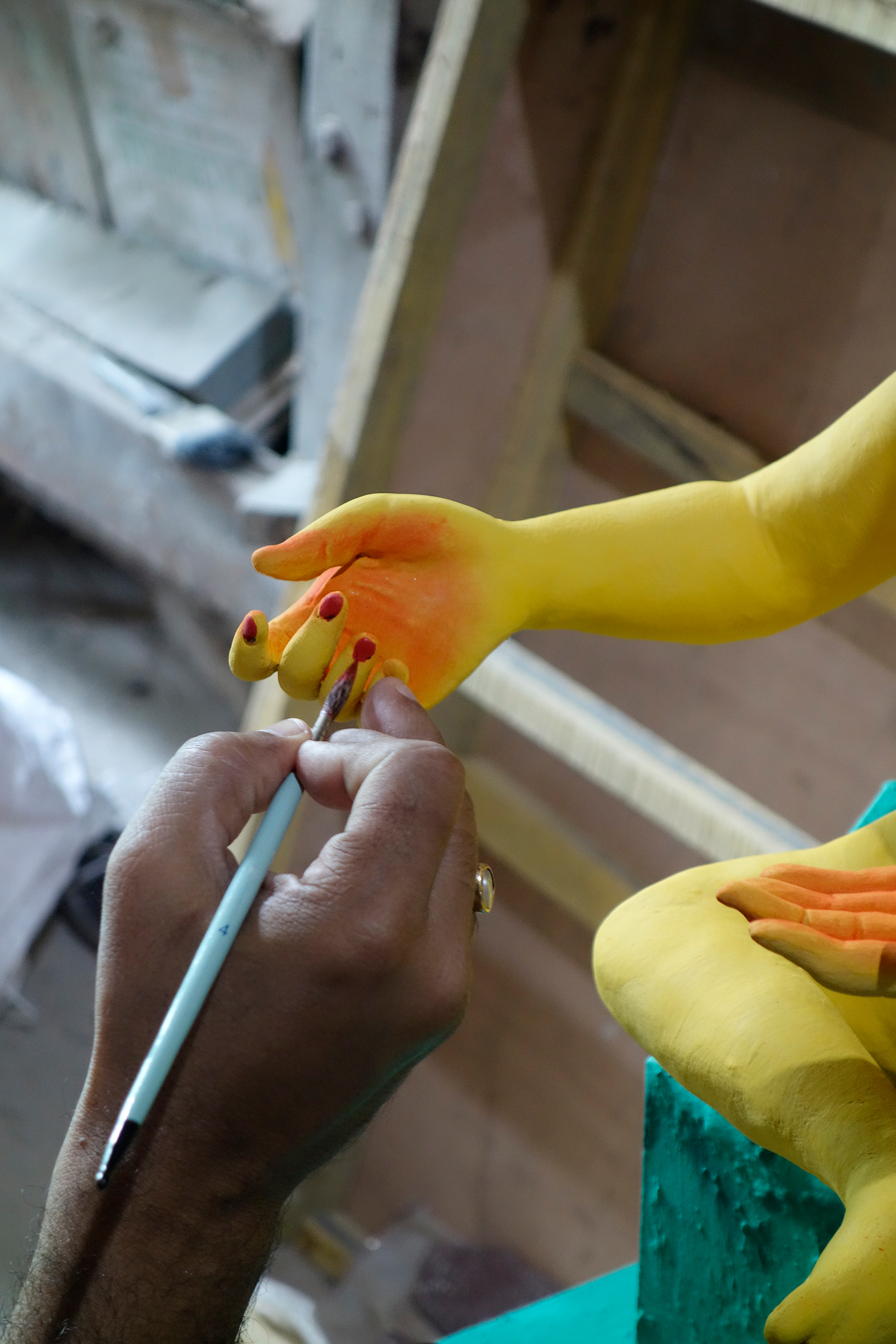
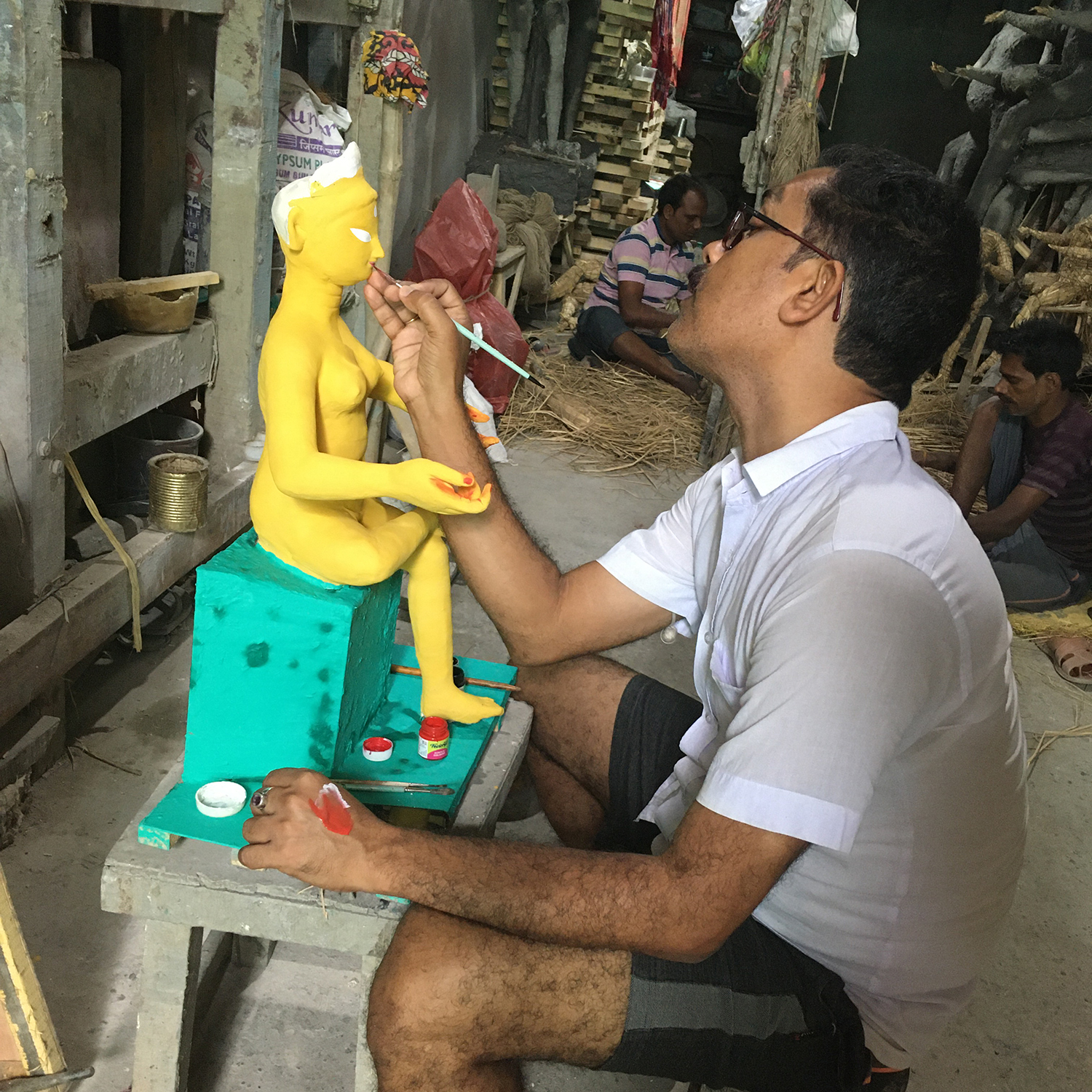 Naba Kumar Paul delicately painting the face details
Naba Kumar Paul delicately painting the face detailsA loose red powder is brushed across the palms and their lines drawn in red paint. The feet are painted with the same red around their edges and the toes.
I have heard of autonomous sensory meridian response (ASMR) - the subjective experience of low-grade euphoria characterised by a combination of positive feelings and a distinct static-like tingling sensation on the skin – which can occur when experiencing slow, meticulous and repetitive visual stimuli. My ex often experiences this but it has never happened to me before. With this particular recipe of stimuli, I feel it for the first time.
I sit transfixed watching this work, in a mild state of inner peace and calm.
I have heard of autonomous sensory meridian response (ASMR) - the subjective experience of low-grade euphoria characterised by a combination of positive feelings and a distinct static-like tingling sensation on the skin – which can occur when experiencing slow, meticulous and repetitive visual stimuli. My ex often experiences this but it has never happened to me before. With this particular recipe of stimuli, I feel it for the first time.
I sit transfixed watching this work, in a mild state of inner peace and calm.
It is through the painting of the eyes that the inanimate clay object is transposed into an idol. Before this point, the object is the sum of its matter and can be handled accordingly. After the eyes are added, the figure must be treated with the reverence of an idol.
The shape of the eyes identifies the character and mood of the idol, which in turn dictates the rest of the expression, how the eyes are painted and the colour of the figure. The detailing is clearly specific and Naba applies the paint with a very fine brush, steady hand and confident stroke. There is a red line, a black and a shadow line. Annapurna has the third eye painted on her forehead.
Now that paint has been applied and the object is near completion, it is interesting to me that it feels further away, in terms of my connection to it. Aesthetically it is not to my taste. Symbolically, as a non-Hindu, I lack a spiritual connection to what is now ‘an idol’, rather than a more open embodiment of the collection of matter and processes that formed it. Also, the idols really come in to their own once they are dressed and bejewelled.
I found the raw materials of the straw and clay and their metamorphosis throughout the production stages so rich and full of potential. Somehow the figure has become solidified in a particular way through the application of the paint, a barrier of sorts, disguising this material richness. I feel certain that it is the materials and methods of production that should play the lead role in any future public exhibition component back in the UK.
Tuesday 17th March 2020
The shape of the eyes identifies the character and mood of the idol, which in turn dictates the rest of the expression, how the eyes are painted and the colour of the figure. The detailing is clearly specific and Naba applies the paint with a very fine brush, steady hand and confident stroke. There is a red line, a black and a shadow line. Annapurna has the third eye painted on her forehead.
Now that paint has been applied and the object is near completion, it is interesting to me that it feels further away, in terms of my connection to it. Aesthetically it is not to my taste. Symbolically, as a non-Hindu, I lack a spiritual connection to what is now ‘an idol’, rather than a more open embodiment of the collection of matter and processes that formed it. Also, the idols really come in to their own once they are dressed and bejewelled.
I found the raw materials of the straw and clay and their metamorphosis throughout the production stages so rich and full of potential. Somehow the figure has become solidified in a particular way through the application of the paint, a barrier of sorts, disguising this material richness. I feel certain that it is the materials and methods of production that should play the lead role in any future public exhibition component back in the UK.
Tuesday 17th March 2020
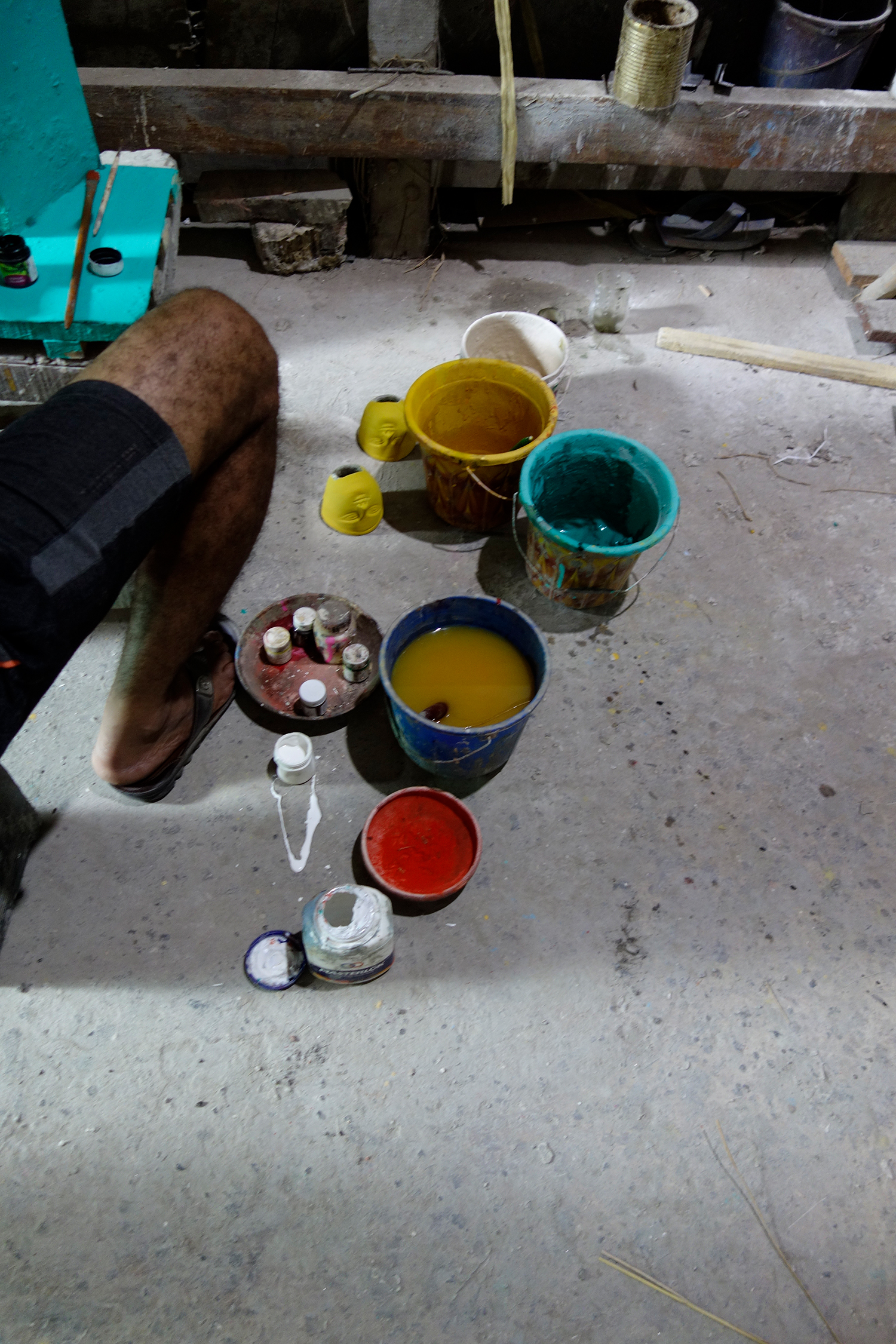
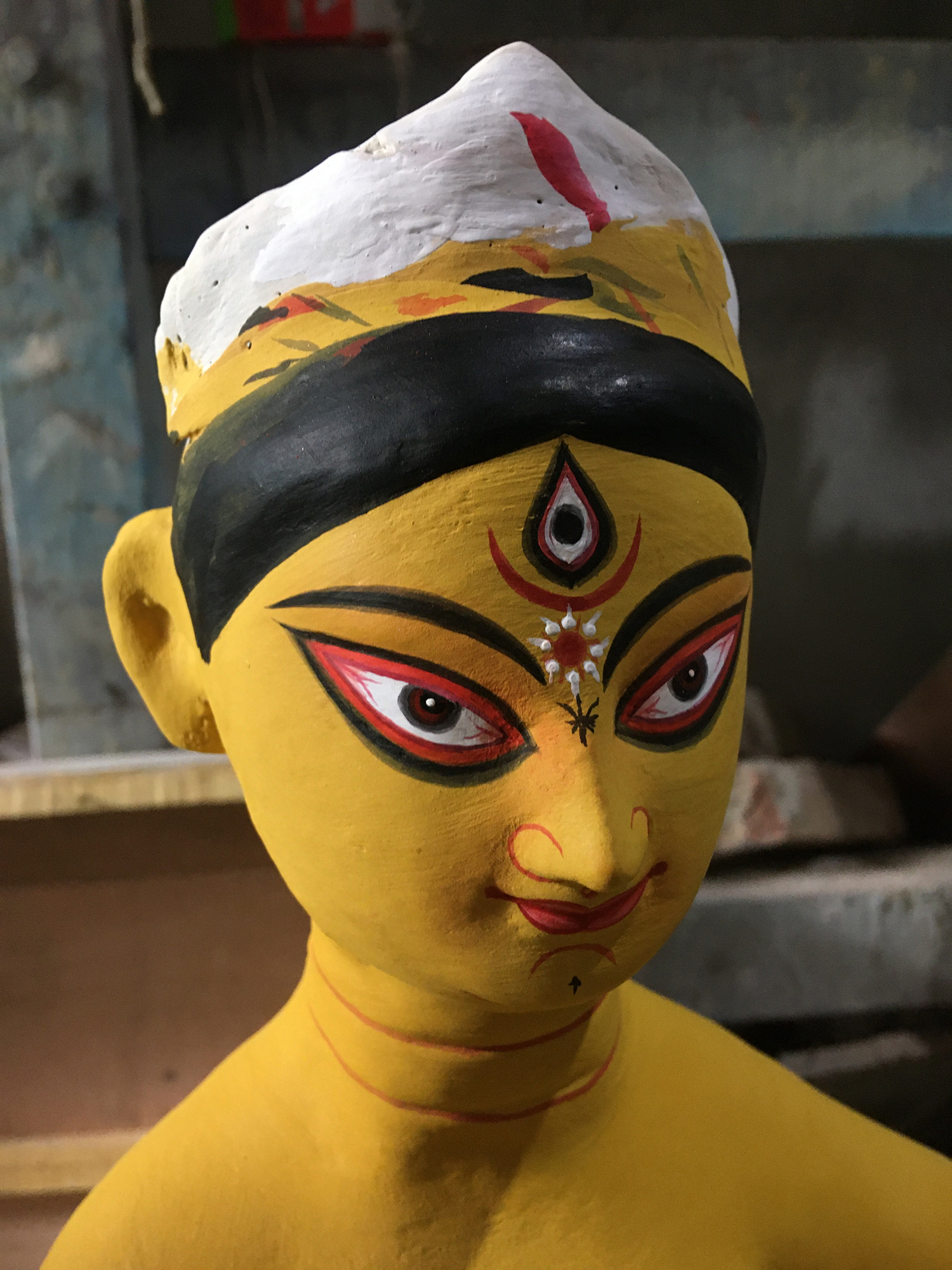
The finished face of Annapurna
British Council and City of Culture 2021, Coventry - International Changemakers, 2020